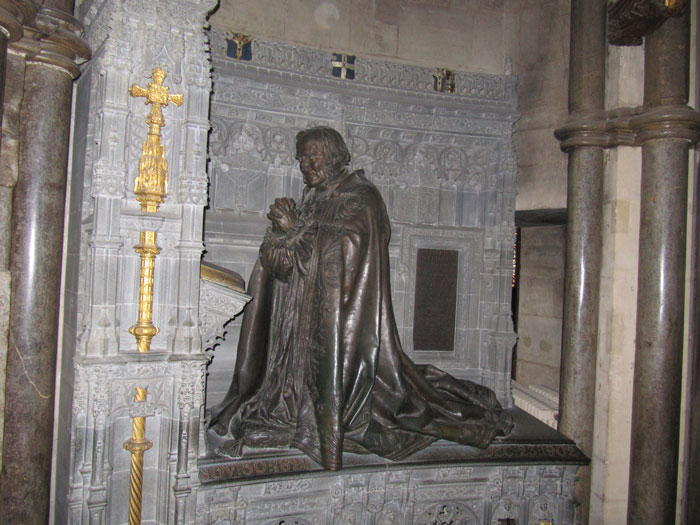click here for more details on Frederick Temple
Archbishop of Canterbury (1896-1902)
Monument designed by William Douglas Caröe, Effigy by Frederick William Pomeroy RA
Frederick Temple presided over the coronation of King Edward VII and Queen Alexandra in 1902. His second son William Temple became Archbishop of Canterbury in 1942. Frederick Temple collapsed while delivering a speech in the House of Lords. Following a short illness he died three weeks later at Lambeth Palace.
The monument on the south wall of the Corona has been shaped to fit unobtrusively in the space between two sets of Purbeck Marble columns, the tomb location having been preferred by Caröe. The late archbishop’s effigy is in bronze (an alloy of mostly copper and tin) and he is depicted kneeling in prayer.

The monument provides a rare glimpse of an unusual geological material known most commonly as Polyphant Stone. Polyphant Stone (a.k.a. Polyfant Stone or Hick’s Mill Stone) is named after the Cornish village of Polyphant located a few miles from Launceston. Polyphant Stone is an intrusive igneous rock known as a picrite (an olivine-rich basalt) that has been altered by hot fluids (metamorphosed) to form new minerals including talc and chlorite. The consequent softness of the minerals in the rock makes it a very popular material for sculpting and once polished it possesses a dark grey-green reflective surface. Frederick Temple’s mother’s side was of Cornish descent and as the last Bishop of Exeter whose diocese included Cornwall he was very much in favour of dividing the diocese. These links with Cornwall may have been influential in the choice of material for his monument. Unfortunately its location beyond the roped-off entranceway to the Corona does not allow for a good appreciation of the stone, or of the memorial.
The monument and canopy have been gilded and various design elements have been picked out in bold colours. The canopy is of oak.
